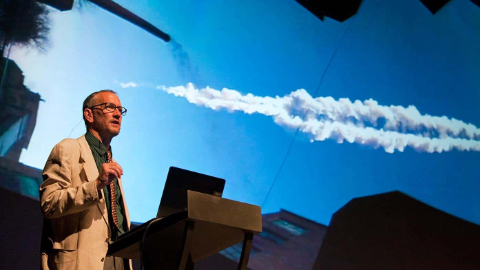
2020 Asteroid Day LIVE – Seeing Is Believing: the Art of Asteroid Computer Simulations
2020 Asteroid Day LIVE – Seeing Is Believing: the Art of Asteroid Computer Simulations https://asteroidday-uploads.s3.eu-central-1.amazonaws.com/wp-content/uploads/2020/06/18021027/Parent-mbody-heating.gif 400 400 Asteroid Day https://asteroidday-uploads.s3.eu-central-1.amazonaws.com/wp-content/uploads/2020/06/18021027/Parent-mbody-heating.gif

A comparison of two interstellar objects traveling through out solar system.
Ever since the discovery of the first asteroid, Ceres in 1801, these enigmatic space rocks have been reluctant to give up their secrets. No matter how big the telescopes used to look at them, they have stubbornly refused to appear as anything more than a simple point of light and no details could be seen on these tiny worlds. This is why in 1802, the Hanoverian astronomer William Herschel proposed that they be called asteroid, meaning star-like.
Thankfully, we have come a long way in the intervening two centuries and while there is still so much to learn about asteroids, astronomers are now gathering plenty of data – and all of it needs analysis and interpretation. One of the key modern techniques to do this is data visualisation.
Data visualisation is the act of taking numerical information and presenting it in a visual context. In its simplest form, this could be a graph or a map but modern visualisations harness the power of computer graphics to render three dimensional images and even whole movies of scientifically accurate behaviour and movement.
Using these techniques, we can see the behaviour of whole populations of asteroids around the Sun, watch the strange ways in which they rotate, see the effects of an asteroid plunging into our atmosphere, or the way in which gravitational forces distort asteroids that fly past harmlessly in space.
Not only are these visualisation tools providing unique insights into the science of asteroids, they are also allowing these results to be more easily communicated to other scientists and the general public. They even allow the scientists who generate them to gain a deeper understanding of the objects they are studying, even to the point of building up an intuition about the physics taking place.

Juventas Diddymoon

Mark Bolsough
Chair, Asteroid Day Expert Panel (ADXP). Physicist, Sandia National Laboratories

Dr. Yun Zhang
Astrophysicist, Côte d’Azur Univ. & Observatory

Dr. Ronald Ballouz
Astrophysicist, Lunar and Planetary Lab, University of Arizona

Daniella DellaGiustina
Planetary Scientist, Lunar and Planetary Lab, University of Arizona


